|
|||||||||||
| |
||||||||||||||
|
||||||||||||||
| |
||||||||||||||
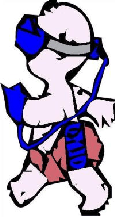 A wearable computer is a computing device small and light enough
to be worn on one's body without causing discomfort. Unlike a laptop
or a palmtop , wearable computer is constantly turned on and interacts
with the
a real-world task.
Information could be even very context sensitive.
A wearable computer is a computing device small and light enough
to be worn on one's body without causing discomfort. Unlike a laptop
or a palmtop , wearable computer is constantly turned on and interacts
with the
a real-world task.
Information could be even very context sensitive.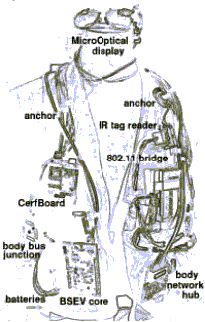
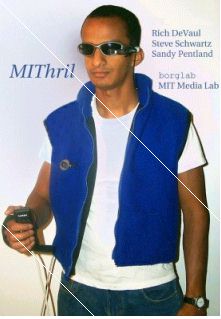
The system gathers real world information through a well-defined API. The current implementation includes keyboard input, network input, speech recognition input, video camera input, G.P.S. input and infrared input. This stage helps in connecting devices on the fly, and provides a device independent abstract layer. Any necessary pre-processing of the data is done in the next stage.
The core of the system contains a basic natural language processor, which performs sentence translations. This converts a sentence into a command stream from which two pieces of information are extracted, which service to invoke and how the output should be rendered. A service manager is responsible for the instantiationand monitoring of the services. The service manager also checks and queues commands to provide resilience against system failures.
The output stage takes a modal neutral result from a service and makes a decision on how to render the information. The decision is made based on two criteria, what the user has asked for, and how the system perceives the users current context/environment.
If the user has asked to be shown a piece of information, this implies a visual rendition. If the system detects that the user is moving or busy with an activity (through the input sensors), an assumption can be made that theuser attention might be distracted if results are displayed in front of him (Imagine what would happen if the user was driving)! In this case the system will override the users request and would redirect the results to a more suitable renderer, such as speech.
Augmented Reality
Wearable computing introduces new concepts ‘mediated reality’ and
‘augmented reality’, which are very interesting to know about.
Mediated reality refers to encapsulation of the user's senses by incorporating
the computer with the user's perceptive mechanisms, and is used to process the
outside stimuli. For example, one can mediate their vision by applying a computer-controlled
camera to enhance it. The primary activity of mediated reality is direct interaction
with the computer, which means that computer is "in charge" of processing and
presenting the reality to the user.
Augmented Reality
combines real world scenes and virtual scenes, augmenting the real world
with additional information. The computer must be able to operate in the background,
providing enough resources to enhance but not replace the user's primary experience
of reality. This can be achieved by using tracked see-through display units
and earphones to overlay visual and audio material on real objects. This technology
adds value to the human knowledge, memory & intelligence.
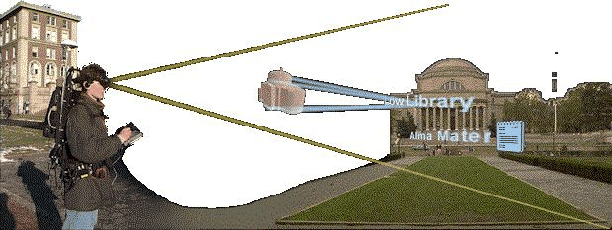
An example of an AR application is a guidebook as above. As the tourist walks
around the library, his wearable computer uses sensors, for example a combination
of GPS and head tracking equipment, to detect his physical position and orientation.
Some text describing the library is shown on the display unit over the actual
building. The wearable computer assists further in enhancing the value of the
real world experience, using augmented reality.
Display Systems
The output device of a wearable computer could be either a head-mounted display
(HMD) unit with an earpiece or
only the earpiece for some applications. Though there could be several other
display devices intended for specific applications, HMD systems are of interest
in the conversation of wearable computers.

There are two different
types of HMD systems. The first one, intended for industrial or regular use
will have a see-through lens and a small projection system. Only on need basis,
the processing system may project the output data onto the lens. The projection
usually happens only on one of the lenses and the other lens remains free for
clear vision.
 The second type of head-mounted display is of blocking type and requires the
full-attention of the user. This is mostly for 3D modeling, used for understanding
complex mechanical design systems or for personal entertainment requirements.
The HMD systems shown in these pictures have both the earpiece and the mouthpiece
built into them. The HMD systems are already well deep into the development
cycle as of today, and do support several attractive features like wireless
connectivity, external connectors for audio & video, and control settings.
The second type of head-mounted display is of blocking type and requires the
full-attention of the user. This is mostly for 3D modeling, used for understanding
complex mechanical design systems or for personal entertainment requirements.
The HMD systems shown in these pictures have both the earpiece and the mouthpiece
built into them. The HMD systems are already well deep into the development
cycle as of today, and do support several attractive features like wireless
connectivity, external connectors for audio & video, and control settings.
Input Devices
By now, you would
probably be having a fair understanding of the criteria of selection for input
devices for WCs. But there is no holy grail for an input device of a wearable
computer.
Speech recognition may appear as the most suited input
device, but may not be preferred in all kinds of applications & environments,
due to privacy and performance issues.
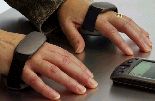
Handwriting & Keyboard could be one of the most efficient input devices,
provided the input device is not too small or awkward. Research in this wearable
domain is resulting in combination products like the SenseBoard shown in picture.
This device is just worn on the hands or wrists and senses the typing input
or handwriting. This does not have any cables and communicates on infrared.
Gesture Input
devices are simple, compact, and optimized for wearable use. These devices
receive inputs from the natural gestures. Ubi-Finger is such a device, but has
not been tested for all types of applications.
But the point to
be taken is that the user needs to be open-minded and adaptable to the emerging
input devices, in order to find the best combination.
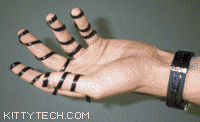 Thumb
Typing - Carsten Mehring, a mechanical engineer at the University of California,
Irvine, has come up with a device that turns your hands into a qwerty-style
keyboard. Mehring’s device uses six conductive contacts on each thumb—three
on the front and three on the back—to represent a keyboard’s three lettered
rows. Contacts on the tips of the remaining eight fingers represent its columns.
Touching the right index finger to the middle contact on the front of the right
thumb, for instance, generates a j. The top contact on the thumb yields a u,
while the middle contact on the back of the thumb would produce an h. Mehring
says the similarity to typing makes his input device easier to master than others
that require an entirely different set of motions. He has applied for a patent
and hopes to market a product by year-end of 2002.
Thumb
Typing - Carsten Mehring, a mechanical engineer at the University of California,
Irvine, has come up with a device that turns your hands into a qwerty-style
keyboard. Mehring’s device uses six conductive contacts on each thumb—three
on the front and three on the back—to represent a keyboard’s three lettered
rows. Contacts on the tips of the remaining eight fingers represent its columns.
Touching the right index finger to the middle contact on the front of the right
thumb, for instance, generates a j. The top contact on the thumb yields a u,
while the middle contact on the back of the thumb would produce an h. Mehring
says the similarity to typing makes his input device easier to master than others
that require an entirely different set of motions. He has applied for a patent
and hopes to market a product by year-end of 2002.
Networks
We need to discuss
two different kinds of networks in reference to a wearable computer. One is
to connect the device to the external world and the other is to interconnect
the various components, the later one being new for wearable computers.
The first issue of
connecting to the WC to the external world has several choices; WAP, or Cellular
Digital packet data. This aspect of networking is not specific for a wearable
computer, and can evolve over time, from other electronic gadgets.
The second issue
of interconnecting the various parts of the WC, may involve both wired and wireless
connections. CPU, storage unit and similar peripherals will be connected with
or without cables to the wearable motherboard, which is a garment with (physically)
flexible bus and standard expansion slots. Peripherals like HMD and wrist/finger
worn devices may use standard wireless connections like Bluetooth.
There could also
be a third type of communication, two wearable computers talking to each other.
This near field networking could be on infrared (IrDA or IRX) or radio based
systems, to solve a need, which will invariably arise to exchange information
between two users.
Power sources
Batteries add size,
weight, and inconvenience to wearable computers. There are several ways of harnessing
the energy expended during the user's everyday actions to generate power for
one’s computer, thus eliminating the impediment of batteries. However,
there is no stopping to use to any of the miniature batteries, for example Lithium,
Li-MnO2, Li-C, that are currently being used in electronic gadgets.
Body Bus
Tom Zimmerman of MIT has shown that the non-contact coupling between the user’s
body and weak electric fields can be used to create and sense tiny nano-amp
currents in the user’s body. Modulating these signals creates Body Net,
a personal-area network that communicates through the skin. Using roughly the
same voltage and frequencies as audio transmissions, this will be as safe as
wearing a pair of headphones.
Keeping data in the human body avoids the intrusion of wires, the need for an
optical path for infrared, and conventional problems such as regulation and
eavesdropping.
Your shoe computer
can talk to a wrist display and keyboard and heads up glasses. Activating your
body means that everything you touch is potentially digital. A handshake becomes
an exchange of digital business cards, a friendly arm on the shoulder provides
helpful data, touching a doorknob verifies your identity, and picking up a phone
downloads your numbers and voice signature for faithful speech recognition.
Every emerging discipline
in computing is born first as a theoretical approach, almost a dream in the
mind of the inventor. Some of such theories have clear practical ramifications,
such as encryption algorithms. Others, on the other hand, take some time to
evolve from the concepts on paper to something that can be applied in the real
world. This could be one such example.
Challenges
& Limitations in Wearable Technologies
The biggest challenge in wearable systems is to identify effective interaction modalities for wearable computers. Development of the software for wearable computers which accurately models the common user tasks is probably the most significant challenges faced by wearable system designers.
The other software challenges include integration of information repositories that augment limited device capabilities. Consider a scenario where a streaming video is augmenting the user's visual data coupled with with cross-domain indexing and data correlation.
Coming to the discussion of current limitations on hardware technologies for wearable computing, there are four major problems – power, networking, privacy and interface. Adding more features to the wearable device requires more power and generates more heat. This imposes a restriction to design systems that take little power and little space and last a long time."
To explain the second limitation with networking in wearable devices, first we need to understand that networking may never be truly ubiquitous; there will always be places where access to the Internet will not be simply be available. The inter-component communication using the on-body wireless bus (an internal electrical pathway along which signals are sent from one part of the computer to another) is still an area of research.
Privacy is not yet a limitation, but may be a limitation in future. Wearable computers allow you to have access to information that you normally wouldn’t have. According to Dr starner, one can record conversations, keep personal notes, schedule, and use diary on the wearable. The first part of the privacy is to protect one's own personal information and the second part is to prevent the wearable user from stealing other's information. With massive amounts of information available right on your eyes, the user is expected to use the device judiciously.
The last, the interesting and the most haunting problem is "How do we communicate with the computer and how does it communicate to us?". Which is the most effective way of communciating to the device and back to the human? What are the prime Ergonomics issues and what makes the device more convenient? This answer for this would only evolve along the time, and there may not be any perfect answer to this question.
Applications
of Wearable Computing
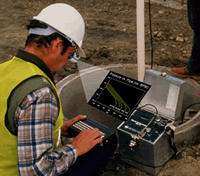 something useful with this thing?" Perhaps the strongest reason
one should respond
with "Many things
" and "Yes, you can!" lies in the origin of wearable computing.
something useful with this thing?" Perhaps the strongest reason
one should respond
with "Many things
" and "Yes, you can!" lies in the origin of wearable computing.
The adjacent photograph
shows a real-life example of a mining engineer doing a chemical analysis of
a sample live on the field. Time is not very far to see them from coming into
as consumer appliances as well.
Privacy & Health Issues
Though wearable computing
does not raise any new privacy issues, it is true that the most useful information
is also most personal. Just because the wearable computers can be used for surveillance
purposes, does not mean that they are being used.
Wearable computing
does not involve any privacy issues which otherwise cannot be done. This just
helps getting around with what you mostly want, what you mostly do, what you
mostly like to do anywhere and everywhere.
Health and Safety
considerations will be important when one is wearing these things all his waking
hours (and arguably sleeping hours too!). Remember the Carpal Tunnel Syndrome?
Last but not the least, the resulting outfits shall be fashionable and provide
the buyer with a choice of fashions. After all, one doesn’t want to go
to a formal dinner looking like C3PO.
Conclusion
We have all the technologies
needed to make a viable wearable computer today. Lot of research and experiments
for practical & commercial use of WC are going on around the world. Several
varieties of WCs are indeed commercially available, but as of now most of them
are tailor made for specific applications. It is only a matter of time before
the consumer community accepts the idea, manufactures pick up patron ship and
the Catch-22 cycle of mass-production.
The paradigm shift
that the WC will bring; computer working along with you instead of you working
at the computer, will have similar impact to the paradigm shift brought by the
earlier PCs. It will augment the user’s senses, intellect, memory and
provide him with huge amount of computation power and information (both local
and networked), without interfering from what he doing. Unlike Artificial Intelligence
(attempts to emulate human intelligence in the computer), WCs works alongside
the human, both doing what each is better at.
After a few cycles
of evolution, the wearable computer will become highly ergonomic and a user,
over an extended period of usage, will feel it as a true extension of mind and
body. The combined capability of resulting synergistic whole will far exceed
the “parts”. This will undoubtedly enhance the quality of life of
the user, at work place and in all facets of daily life.
References & Acknowledgements
All images in this article
have been reproduced with consent from original authors, with due acknowledgements
here in the references section.
The
Humane Interface by Raskin, Jef. This recently published book goes into
greater depth about the advantages of quasimodes and the primacy of text over
icons. It also discusses past implementations of the LEAP text navigation method
and is a good summary of evaluation techniques for determining quantitative
user interface efficiency.
Augmented Reality,
Research Projects on Computer Augmented Environment projects at Sony Computer
Science Laboratories, Japan
http://www.csl.sony.co.jp/project/ar/ref.html
A Wearable Application
Integration Framework, Neill J Newman, University of Essex
http://www.cs.washington.edu/sewpc/papers/newman.pdf
MIThril, research
project at MIT, hardware platform combines body-worn computation, sensing, and
networking in a clothing-integrated design. The MIThril software platform is
a combination of user interface elements and machine learning tools built on
the Linux operating system
http://www.media.mit.edu/wearables/mithril
Linux Wearable,
work being done in the world of linux for enabling wearable technologies
http://www.linuxdoc.org/HOWTO/Wearable-HOWTO.html
Steve Mann,
Univ of Toronto, Keynote address on “Wearable Computing as means for personal
empowerment”
http://wearcam.org/wearcompdef.html
Ripley Wearable
Computer, Commercial wearable products currently available on linux
http://www.zerospin.com/ripley/index.html
Proceedings of
The Second International Symposium on Wearable Computers (ISWC '98), 1998
Thad Starner, Brent Schiele, and Alex Pentland. Visual contextual awareness
in wearable computing
Wearable Computing,
Patrick Sinclair, Intelligence, Agents and Multimedia Group Department of
Electronics and Computer Science, University of Southampton
5th International
Symposium of Wearable Computers, 2001, Zurich, http://www.iswc.ethz.ch
Wearable Computer
Systems at Carngie Mellon University
http://www.cs.cmu.edu/afs/cs.cmu.edu/project/vuman/www/home.html
Computer-Augmented
Vision Technology, http://www.cs.unc.edu/~us
Kitty Tech, Keyboard Independent Touch Typing Method by Dr Karsten Mehring, http://www.kittytech.com/
Xybernaut, Manufactures
of wearable computers, HMD.
http://www.xybernaut.com/newxybernaut/home.htm
Origin Instruments Corpn. - Input devices, http://orin.com/index.htm
Virtual Vision: Head Mounted Displays, http://www.virtualvision.com
Kopin Corpn:
Display devices, http://www.kopin.com
i-Glasses: Head
Mounted Display Units, http://www.i-glasses.com/Store/SVGA.php3
Mobile Augmented Reality Systems (MARS), (c) Columbia University Computer Graphics and User Interfaces Lab.
MIT Media Lab Rich DeVaul Alex "Sandy" Pentland Steve Schwartz
(Article dated: Oct' 2002)